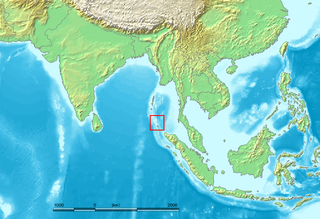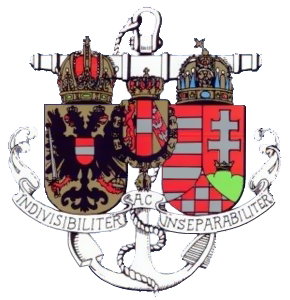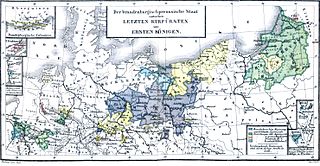
The Andaman and Nicobar Islands is a union territory of India consisting of 571 islands, of which 37 are inhabited, at the junction of the Bay of Bengal and the Andaman Sea. The territory is about 150 km (93 mi) north of Aceh in Indonesia and separated from Thailand and Myanmar by the Andaman Sea. It comprises two island groups, the Andaman Islands (partly) and the Nicobar Islands, separated by the 150 km wide Ten Degree Channel, with the Andaman islands to the north of this latitude, and the Nicobar islands to the south. The Andaman Sea lies to the east and the Bay of Bengal to the west. The island chains are thought to be a submerged extension of the Arakan Mountains.

The Nicobar Islands are an archipelagic island chain in the eastern Indian Ocean. They are located in Southeast Asia, 150 kilometres (93 mi) northwest of Aceh on Sumatra, and separated from Thailand to the east by the Andaman Sea. Located 1,300 kilometres (810 mi) southeast of the Indian subcontinent, across the Bay of Bengal, they are part of India, as the Nicobar district within the union territory of the Andaman and Nicobar Islands.

Colonial India was the part of the Indian subcontinent that was occupied by European colonial powers during the Age of Discovery. European power was exerted both by conquest and trade, especially in spices. The search for the wealth and prosperity of India led to the colonisation of the Americas after Christopher Columbus went to the Americas in 1492. Only a few years later, near the end of the 15th century, Portuguese sailor Vasco da Gama became the first European to re-establish direct trade links with India by being the first to arrive by circumnavigating Africa. Having arrived in Calicut, which by then was one of the major trading ports of the eastern world, he obtained permission to trade in the city from the Saamoothiri Rajah. The next to arrive were the Dutch, with their main base in Ceylon. Their expansion into India was halted after their defeat in the Battle of Colachel to the Kingdom of Travancore, during the Travancore–Dutch War.
Nancowry is an island in the central part of the Nicobar Islands chain, located in the northeast Indian Ocean between the Bay of Bengal and the Andaman Sea.
Trinket Island is one of the 24 islands that make up the Nicobar Islands chain, located in the northeast Indian Ocean between the Bay of Bengal and the Andaman Sea. It is located east of Kamorta Island.

The Austro-Hungarian Navy or Imperial and Royal War Navy was the naval force of Austria-Hungary. Ships of the Austro-Hungarian Navy were designated SMS, for Seiner Majestät Schiff. The k.u.k. Kriegsmarine came into being after the formation of Austria-Hungary in 1867, and ceased to exist in 1918 upon the Empire's defeat and subsequent collapse at the end of World War I.

The Nicobar Islands rain forests is a tropical moist broadleaf forest ecoregion in the Nicobar Islands. The Nicobar Islands are in the Indian Ocean, lying north of Sumatra and south of the Andaman Islands. The islands are politically part of India, although physically closer to Southeast Asia. Millions of years of isolation from the mainland has given rise to a distinct flora and fauna, including many endemic species.

Danish India was the name given to the colonies of Denmark in the Indian subcontinent, forming part of the Danish overseas colonies. Denmark–Norway held colonial possessions in India for more than 200 years, including the town of Tharangambadi in present-day Tamil Nadu state, Serampore in present-day West Bengal, and the Nicobar Islands, currently part of India's union territory of the Andaman and Nicobar Islands. The Danish and Norwegian presence in India was of little significance to the major European powers as they presented neither a military nor a mercantile threat. Dano-Norwegian ventures in India, as elsewhere, were typically undercapitalised and never able to dominate or monopolise trade routes in the same way that British, French, and Portuguese ventures could.
Trimeresurus labialis, commonly called Nicobar bamboo pit viper, is a venomous pit viper species endemic to the Nicobar Islands of India. No subspecies are currently recognized.

SMS Novara was a sail frigate of the Austro-Hungarian Navy most noted for sailing the globe for the Novara Expedition of 1857–1859 and, later for carrying Archduke Maximilian and wife Carlota to Veracruz in May 1864 to become Emperor and Empress of Mexico.

From the 17th century through to the 19th century, the Habsburg monarchy, Austrian Empire, and the Austro-Hungarian Empire made a few small short-lived attempts to expand overseas colonial trade through the acquisition of factories. In 1519–1556 Austria's ruler also separately ruled Spain, which did have a large colonial empire. However no other Austrians were involved when Emperor Charles V held the crown of both the Spanish Empire and the Holy Roman Empire and the Spanish colonies were not linked to Austria.
Teressa is one of the Nicobar Islands, India.
William Bolts (1738–1808) was a Dutch-born British merchant active in India. He began his career as an employee of the East India Company, and subsequently became an independent merchant. He is best known today for his 1772 book, Considerations on India Affairs, which detailed the administration of the East India Company in Bengal which began shortly after their victory in the Battle of Plassey in 1757. The observations and experiences he recorded offer a unique resource for scholars inquiring into the nature of Company rule in Bengal. Throughout his life, Bolts continued to propose and execute various trading ventures on his own behalf and in conjunction with various commercial and governmental partners. The ventures of individual traders like Bolts did much to spur governments and large corporations into the expansion of their own interests.
Austrian East India Company is a catchall term referring to a series of Austrian trading companies based in Ostend and Trieste. The Imperial Asiatic Company of Trieste and Antwerp and Asiatic Company of Trieste or the Trieste Company were founded by William Bolts in 1775 and wound up in 1785.
Jhoola is a village in the Nicobar district of Andaman and Nicobar Islands, India. It is located in the Nancowry tehsil.
Ramzoo is a village in the Nicobar district of Andaman and Nicobar Islands, India. It is located in the Nancowry tehsil.
Chowra is an island in the Andaman and Nicobar islands group of India. It is located to the north of Teressa island and to the south of Battimalv Island in the Indian Ocean. It is also known as Choura, Tatat or Sanenyo.

When the German Empire came into existence in 1871, none of its constituent states had any overseas colonies. Only after the Berlin Conference in 1884 did Germany begin to acquire new overseas possessions, but it had a much longer relationship with colonialism dating back to the 1520s. Before the end of the Holy Roman Empire in 1806, various German states established chartered companies to set up trading posts; in some instances they also sought direct territorial and administrative control over these. After 1806, attempts at securing possession of territories overseas were abandoned; instead, private trading companies took the lead in the Pacific while joint-stock companies and colonial associations initiated projects elsewhere, although many never progressed beyond the planning stage.
The Andaman and Nicobar Islands is an archipelago of 572 islands of which 37 are inhabited. It is a union territory of India.

Frederik Adolph de Roepstorff was a Danish philologist who worked in the Andaman penal colony in India, where he was shot dead by a convict. He studied the languages of Andaman and Nicobar tribes and collected numerous natural history specimens. The Andaman masked owl was named after him by Hume.











